AES New York 2018
Paper Session P04
P04 - Transducers—Part 1
Wednesday, October 17, 2:30 pm — 5:30 pm (1E11)
Chair:
Sean Olive, Harman International - Northridge, CA, USA
P04-1 Numerical Optimization Strategies for Acoustic Elements in Loudspeaker Design—Andri Bezzola, Samsung Research America - Valencia, CA USA
Optimal design of acoustic loudspeaker design elements, such as waveguides and phase plugs, often requires extensive experience by the designer. Numerical simulations and optimization algorithms can aid in reducing the design-test-optimize cycle that is traditionally applied. A general mathematical framework for numerical optimization techniques is introduced and three algorithms of design optimization are reviewed: parameter optimization, shape optimization, and topology optimization. This paper highlights strengths and drawbacks of each method with the use of real-world design of a waveguide and two phase plugs. Where possible, the results are confirmed with prototypes and measurements. The work shows that excellent results can be achieved in just one design iteration with the help of numerical optimization methods.
Convention Paper 10046 (Purchase now)
P04-2 An Acoustic Model of the Tapped Horn Loudspeaker—Marco Berzborn, RWTH Aachen University - Aachen, Germany; Michael Smithers, Dolby Laboratories - McMahons Point, NSW, Australia
A lumped-parameter model of the Tapped Horn loudspeaker–a design where the loudspeaker driver radiates into the throat as well as the mouth of the horn simultaneously–is presented. The model enables the estimation of the far-field sound pressure response from the Thiele/Small parameters of the loudspeaker driver and an additional analytic two-port matrix representation of the Tapped Horn. Simulations, performed using the model for subwoofers, are compared to measurements from an actual loudspeaker.
Convention Paper 10047 (Purchase now)
P04-3 A Survey and Analysis of Consumer and Professional Headphones Based on Their Objective and Subjective Performances—Sean Olive, Harman International - Northridge, CA, USA; Omid Khonsaripour, Harman International - Northridge, CA, USA; Todd Welti, Harman International Inc. - Northridge, CA, USA
In previous studies [1–3], we presented two statistical models that predict listeners’ sound quality preferences of headphones based on deviations in their measured frequency response. In this paper the models are applied to 156 different consumer and professional headphones that include a wide range of brands, prices, and headphone categories (e.g., in-ear, on-ear, and around-ear). The goal was to gain a better understanding of how these factors influence the subjective and objective performances of the headphone. The predicted preference ratings of the headphones were compared to ratings given by five different headphone review organizations to determine their correlation. Headphones designed to the current IEC/ITU/EBU standards produce significantly lower sound quality ratings.
Convention Paper 10048 (Purchase now)
P04-4 Minimizing Costs in Audio Devices through Efficient End-of-Line Testing—Wolfgang Klippel, Klippel GmbH - Dresden, Germany
Variances in the parts and uncertainties in the assembling process degrade the performance and the reliability of the manufactured devices. Defective units increase the manufacturing cost if detected during end-of-line testing or increase the after-sales cost if an undetected failure occurs in the field. This paper addresses the role of end-of-line testing to reduce both kinds of failures and to maximize the performance/cost ratio as seen by the end-user. The selection of sensitive and fast measurements, which can be performed under manufacturing conditions, is the basis for the PASS/FAIL classification. The paper shows that optimal production limits used in EoL-testing minimize the overall cost by considering a clear product definition, information from the particular design, statistical data from manufacturing process and traceability of the field rejects. The general concept presented here is illustrated using practical examples from automotive and other applications.
Convention Paper 10049 (Purchase now)
P04-5 Horn Driver Based on Annular Diaphragm and the Side-Firing Compression Chamber—Alexander Voishvillo, JBL/Harman Professional Solutions - Northridge, CA, USA
This work proposes a new type of compression driver based on an annular flexural diaphragm and a topology that combines part of the diaphragm radiating directly into the horn and the other part loaded by a side-firing compression chamber. This configuration’s design is very simple compared to its predecessors. Acoustical theory, numerical simulations, matrix electrical-mechanical-acoustical model, and the results of real transducer measurements substantiate the new design. The new driver provides performance on par with more complex transducers of a similar format.
Convention Paper 10050 (Purchase now)
P04-6 On the Efficiency of Flown vs. Ground Stacked Subwoofer Configurations—Etienne Corteel, L-Acoustics - Marcoussis, France; Hugo Coste Dombre, L-Acoustics - Marcoussis, France; Christophe Combet, L-Acoustics - Marcoussis, France; Yoachim Horyn, L-Acoustics - Marcoussis, France; François Montignies, L-Acoustics - Marcoussis, France
Modern live loudspeaker systems consist of broadband sources, often using variable curvature line sources, combined with subwoofers. While it is common practice to fly the broadband sources to improve energy distribution in the audience, most subwoofer configurations remain ground-stacked because of practical constraints and alleged efficiency loss of flown configurations. This article aims at evaluating the efficiency of flown subwoofers for large audiences as compared to their ground-stacked counterparts. We use finite element simulations to determine the influence of several factors: baffling effect, trim height. We show that flown configurations remain efficient at the back of the venue while reducing the SPL excess at the front of the audience.
Convention Paper 10051 (Purchase now)
